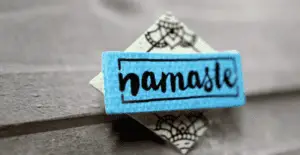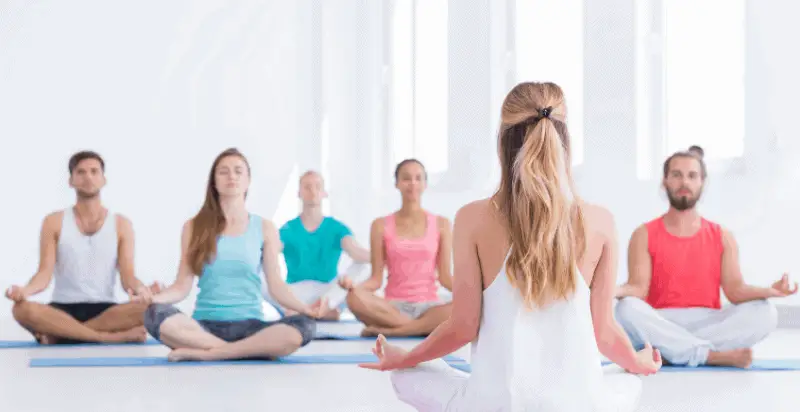Yoga is about getting in touch with your inner self, your mind, and your body. For this reason, yoga is really open and accessible to everyone.
Yoga is often intimidating to beginners because their is so much to learn and new things to take in. For example, you might be in a crowded class surrounded by strangers which is odd at first.
And then there are all of the positions and their names to learn. And your instructor maybe using Sanskrit terms that are also strange at first when you don’t know what they mean.
This article is to help put you at ease so you won’t get discouraged by all of this! For you to appreciate and enjoy and benefit from yoga, you have to feel like you fit in and look forward to going to classes.
In this article we are here to help you feel more at ease and fit into your yoga class and start embracing the yoga culture. One thing that is often confusing is all of the new yoga terms and terminology. We are here to help you understand these terms so they won’t feel so foreign and you will feel more comfortable and start to enjoy your yoga classes.
Yoga Terms and Terminology
Yoga
The most common yoga term is obviously yoga which is interpreted as ‘union’, the union of your mind, body and breath.
Asana
Literally it is translated to ‘seat’, referring to the mainy positions and poses in yoga. Commonly, asana is used to describe a single posture or pose but it is also used to describe a certain yoga style that involves movement. When sanskrit is spoken to say a pose’s name, you will notice that the pose or position’s sanskrit name is followed by asana.
Bandha
In sanskrit this translates to ‘tighten’ ‘hold’ or ‘lock’. Bandha is referring to the muscular ‘locks’ in your body. When these ‘locks’ in your body are engaged by contracting your muscles, it supports the toning and lifting of these particular muscles. Bandhas are used to control and support the energy (prana) flow throughout your body by accessing the ‘locks’ through muscle contractions. The 3 major types of Bandhas you will most likely hear are:
Mula Bandha
This refers to the ‘lock’ in your pelvic area. This is the Bandha you will likely hear more than the others, as Mula Bandha involves toning and lifting the muscles in your pelvic floor.
Uddiyana Bandha
This refers to the ‘lock’ in your abdominal area. Accessing this Bandha will tone and lift the muscles from your diaphragm to your abdominal area.
Jalandhara Bandha
This refers to the ‘lock’ in your throat area.
Chakra
Translating to ‘wheel’, chakras are referring to the energy centers throughout your body from lower spine to the top of your head. Chakras are essentially areas that our energy pathways come together. Chakras are main points of mental, physical and emotional energies.
There are 7 different chakras in all of our bodies:
- Sahasrara – This is referred to as ‘crown’ and is located at the top of your head.
- Ajna – This is referred to as ‘third eye’ and is located in the center of your forehead between your eyebrows.
- Vishuddha – This is referred to as ‘thoat’ and is located in your throat area.
- Anahata – This is referred to as ‘heart’ and is located in the center of your chest.
- Manipura – This is referred to as ‘solar plexus’ and is located in your upper abdomen.
- Svadhisthana – This is referred to as ‘the sacral’ and is located in your lower abdomen.
- Muladhara – This is referred to as ‘the root’ and is located at the base of your spine.
Chaturanga
Drishti
Mantra
Mudra
Anjali
Jnana
Nadi
Namaste

Prana
Pranayama
Savasana
Surya Namaskar
Ujjayi
Referred to as ‘victorious breath’, Ujjayi is a breathing technique that is performed by deeply breathing in and out through your nose. Ujjayi is one of the most difficult breathing techniques used in yoga because it requires you to have a slight construction in your throat, allowing you to be more present and enlivening your sense organs. This technique is often called ‘warriors breathe’ and ‘ocean breath’ as well. In class you may hear your teacher or instructor say “use your Ujjayi breath” or “start your Ujjayi breath and continue to focus on it throughout your practice”.
Vinyasa
Translating to ‘to place in a special way’, Vinyasa is a movement that is linked to breathing. Vinyasa is used as a transition, it is a step-by-step approach to take you from one pose or position and lands you in another pose or position safely. This is often described as a ‘breathing system’ or ‘union of breath’ and is often used in yoga classes to describe the connection between yoga poses or positions.
Some yoga classes are designed to make you get a really good work out and have you sweating a lot, but there are also other types of yoga classes that teach mainly meditation, and are often more of a restorative and gentle type of yoga practice. Yoga classes are usually very welcoming and often accepting, but some yoga classes may not be for you so talk with your instructor or teacher if you feel uncomfortable in your yoga class.
Without the distraction of trying to figure out the sanskrit words that you now know, your yoga practice should go smoother and you can focus more on getting the exercise, breathing techniques, meditation, and spiritual parts of your yoga journey. You don’t need to know the whole sanskrit language, but these terms are useful so you don’t feel so lost in your next or first yoga class.
There are yoga studios that offer classes locally and especially during the pandemic in 2020 there are more and more remote yoga classes online. Those will help make your adjustment to learning yoga much easier to be honest and remove the stress of being new in a studio and feeling like a “newbie” and feeling like people are too close to your mat! (Yes, everyone will relate to this).
Either way, if you’re taking in-person classes or online classes at home, these terms will be helpful in understanding what the instructor or teacher is asking from you.
PS. If there are other terms you would like us to write about, please leave a comment below and we will update this article as needed.

